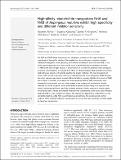High-affinity nitrate/nitrite transporters NrtA and NrtB of Aspergillus nidulans exhibit high specificity and different inhibitor sensitivity
Abstract
The NrtA and NrtB nitrate transporters are paralogous members of the major facilitator superfamily in Aspergillus nidulans. The availability of loss-of-function mutations allowed individual investigation of the specificity and inhibitor sensitivity of both NrtA and NrtB. In this study, growth response tests were carried out at a growth limiting concentration of nitrate (1 mM) as the sole nitrogen source, in the presence of a number of potential nitrate analogues at various concentrations, to evaluate their effect on nitrate transport. Both chlorate and chlorite inhibited fungal growth, with chlorite exerting the greater inhibition. The main transporter of nitrate, NrtA, proved to be more sensitive to chlorate than the minor transporter, NrtB. Similarly, the cation caesium was shown to exert differential effects, strongly inhibiting the activity of NrtB, but not NrtA. In contrast, no inhibition of nitrate uptake by NrtA or NrtB transporters was observed in either growth tests or uptake assays in the presence of bicarbonate, formate, malonate, or oxalate (sulphite could not be tested in uptake assays due to its reaction with nitrate), indicating significant specificity of nitrate transport. Kinetic analyses of nitrate uptake revealed that both chlorate and chlorite inhibited NrtA competitively, while these same inhibitors inhibited NrtB in a non-competitive fashion. The caesium ion appeared to inhibit NrtA in a non-competitive fashion, while NrtB was inhibited uncompetitively. The results provide further evidence of the distinctly different characteristics as well as the high specificity of nitrate uptake by these two transporters.
Citation
Akhtar , N , Karabika , E , Kinghorn , J R , Glass , A D M , Unkles , S E & Rouch , D A 2015 , ' High-affinity nitrate/nitrite transporters NrtA and NrtB of Aspergillus nidulans exhibit high specificity and different inhibitor sensitivity ' , Microbiology , vol. 161 , no. 7 , pp. 1435-1446 . https://doi.org/10.1099/mic.0.000088
Publication
Microbiology
Status
Peer reviewed
ISSN
1350-0872Type
Journal article
Collections
Items in the St Andrews Research Repository are protected by copyright, with all rights reserved, unless otherwise indicated.

